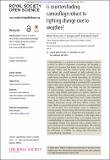Files in this item
Is countershading camouflage robust to lighting change due to weather?
Item metadata
| dc.contributor.author | Penacchio, Olivier | |
| dc.contributor.author | Lovell, P. George | |
| dc.contributor.author | Harris, Julie M. | |
| dc.date.accessioned | 2018-02-16T00:33:30Z | |
| dc.date.available | 2018-02-16T00:33:30Z | |
| dc.date.issued | 2018-02-07 | |
| dc.identifier | 252134669 | |
| dc.identifier | d7ed1051-35e8-4925-82c3-2312bb2e1554 | |
| dc.identifier | 85042750640 | |
| dc.identifier | 000426465700006 | |
| dc.identifier.citation | Penacchio , O , Lovell , P G & Harris , J M 2018 , ' Is countershading camouflage robust to lighting change due to weather? ' , Royal Society Open Science , vol. 5 , 170801 . https://doi.org/10.1098/rsos.170801 | en |
| dc.identifier.issn | 2054-5703 | |
| dc.identifier.other | ORCID: /0000-0002-3497-4503/work/46085837 | |
| dc.identifier.uri | https://hdl.handle.net/10023/12731 | |
| dc.description | This research was supported by the Biotechnology & Biological Sciences Research Council UK, grants 610 BB/J000272/1 to JMH and PGL, and by ISSF funding from The Wellcome Trust to OP. | en |
| dc.description.abstract | Countershading is a pattern of colouration thought to have evolved in order to implement camouflage. By adopting a pattern of colouration that makes the surface facing towards the sun darker and the surface facing away from the sun lighter, the overall amount of light reflected off an animal can be made more uniformly bright. Countershading could hence contribute to visual camouflage by increasing background matching or reducing cues to shape. However, the usefulness of countershading is constrained by a particular pattern delivering ‘optimal’ camouflage only for very specific lighting conditions. In the current study, we test the robustness of countershading camouflage to lighting change due to weather, using human participants as a ‘generic’ predator. In a simulated 3D environment, we constructed an array of simple leaf-shaped items and a single ellipsoidal target ‘prey’. We set these items in two light environments: strongly directional ‘sunny’ and more diffuse ‘cloudy’. The target object was given the optimal pattern of countershading for one of these two environment types or displayed a uniform pattern. By measuring detection time and accuracy, we explored whether and how target detection depended on the match between the pattern of colouration on the target object and scene lighting. Detection times were longest when the countershading was appropriate to the illumination; incorrectly camouflaged targets were detected with a similar pattern of speed and accuracy to uniformly coloured targets. We conclude that structural changes in light environment, such as caused by differences in weather, do change the effectiveness of countershading camouflage. | |
| dc.format.extent | 431529 | |
| dc.language.iso | eng | |
| dc.relation.ispartof | Royal Society Open Science | en |
| dc.subject | Visual search | en |
| dc.subject | Search efficiency | en |
| dc.subject | Shape-from-shading | en |
| dc.subject | Visual camouflage | en |
| dc.subject | Countershading | en |
| dc.subject | Foraging | en |
| dc.subject | BF Psychology | en |
| dc.subject | QL Zoology | en |
| dc.subject | DAS | en |
| dc.subject.lcc | BF | en |
| dc.subject.lcc | QL | en |
| dc.title | Is countershading camouflage robust to lighting change due to weather? | en |
| dc.type | Journal article | en |
| dc.contributor.sponsor | BBSRC | en |
| dc.contributor.institution | University of St Andrews. School of Psychology and Neuroscience | en |
| dc.contributor.institution | University of St Andrews. Institute of Behavioural and Neural Sciences | en |
| dc.identifier.doi | 10.1098/rsos.170801 | |
| dc.description.status | Peer reviewed | en |
| dc.identifier.url | http://rsos.royalsocietypublishing.org/content/5/2/170801.figures-only | en |
| dc.identifier.grantnumber | BB/J000272/1 | en |
This item appears in the following Collection(s)
Items in the St Andrews Research Repository are protected by copyright, with all rights reserved, unless otherwise indicated.

